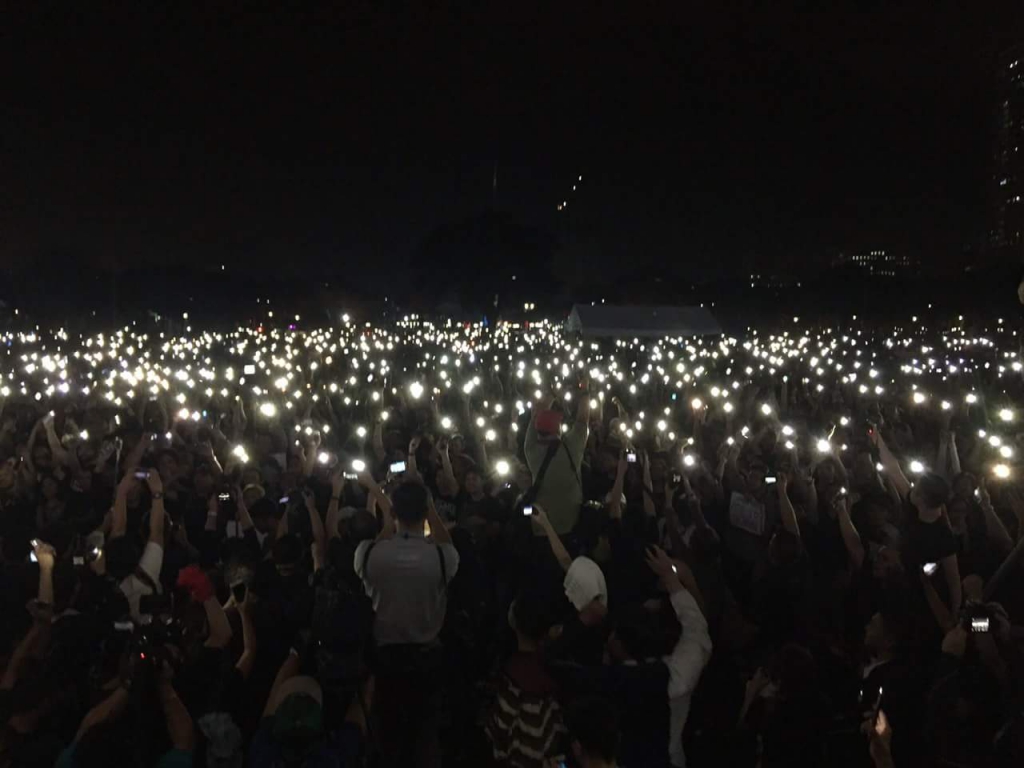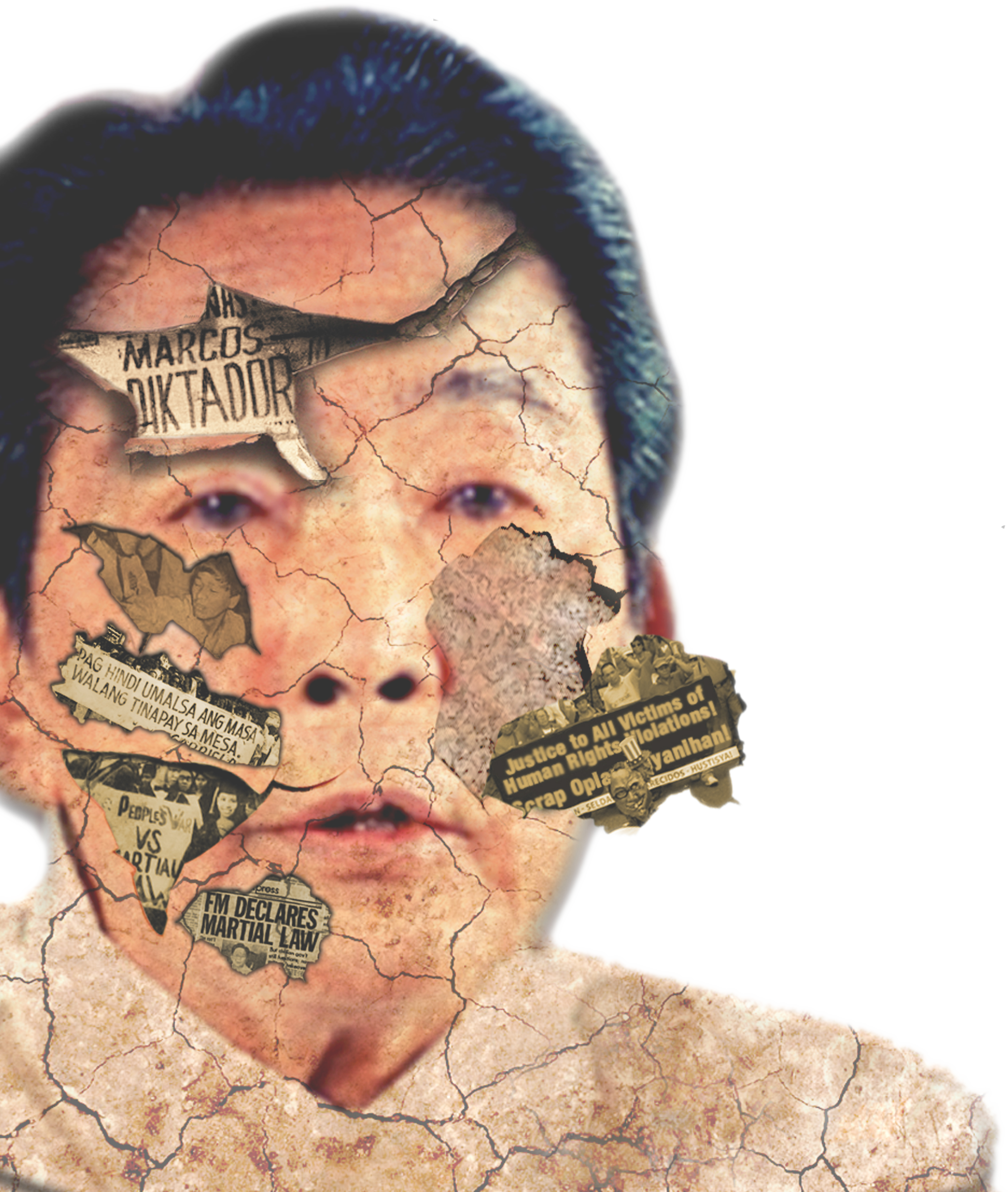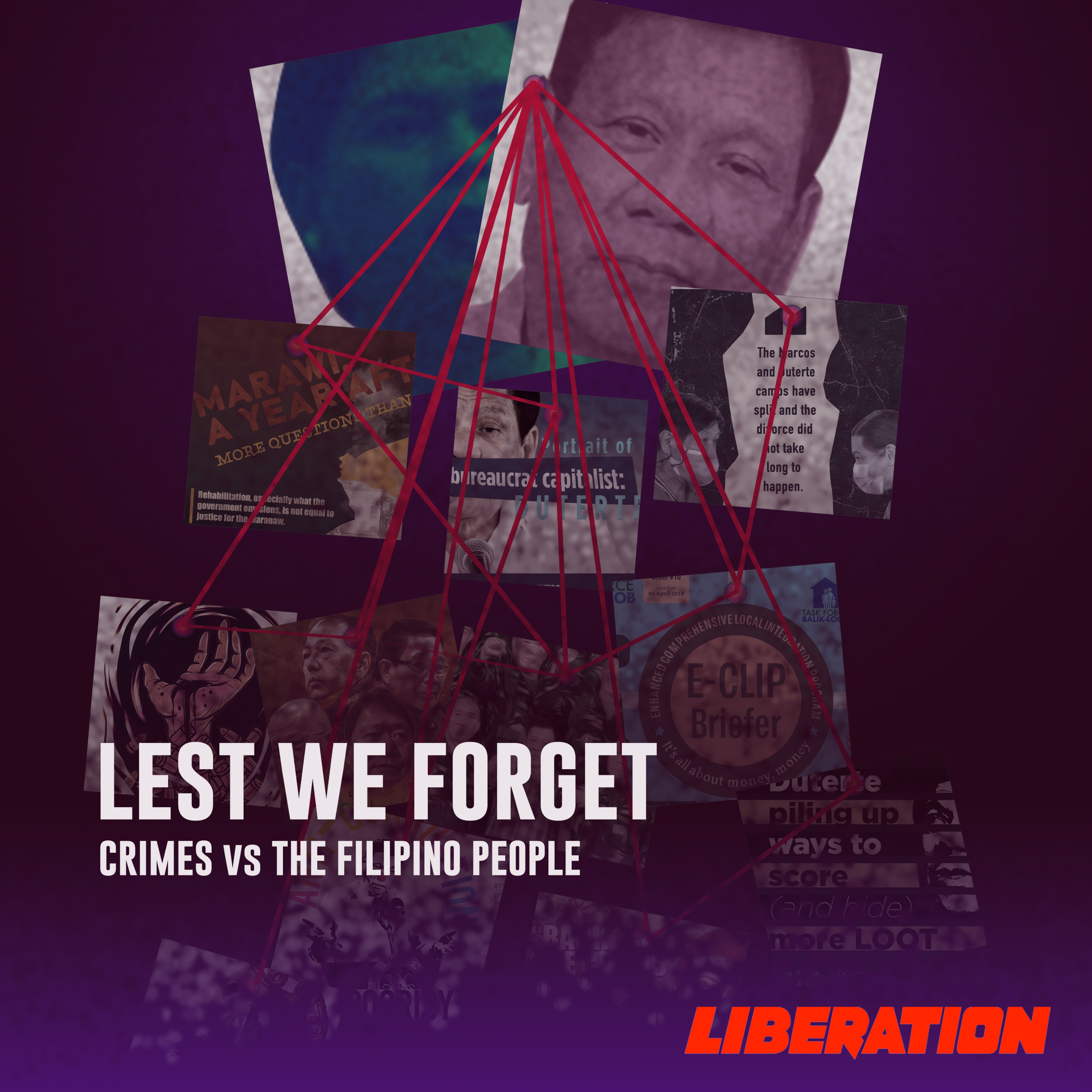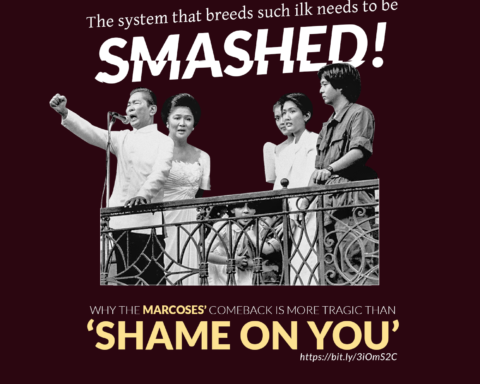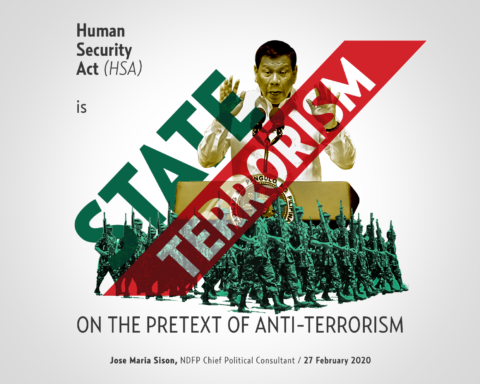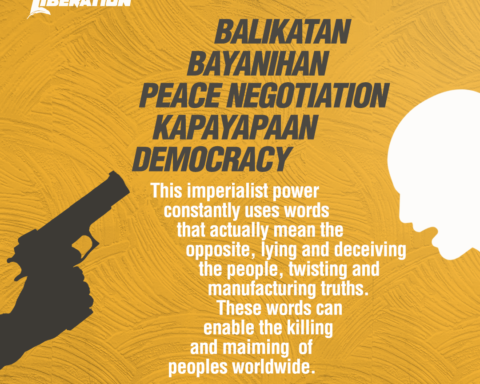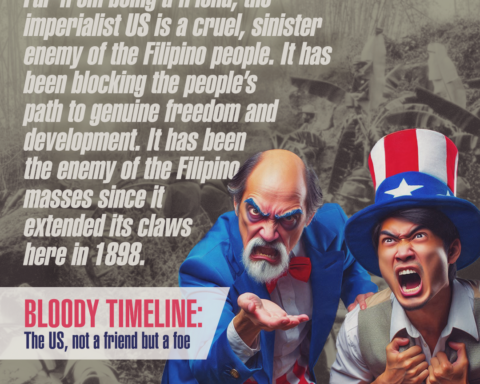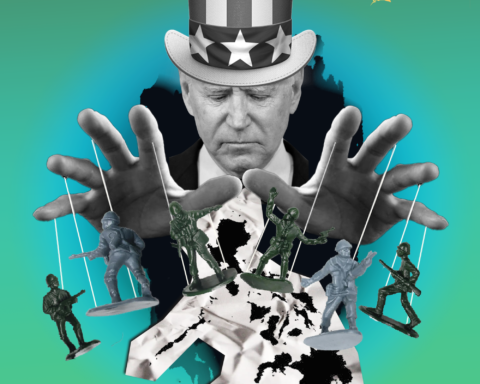by Bukang Liwayway
The overthrow of the Marcos regime by a people’s uprising in 1986 was historic for the Philippines. The growing people’s war in the countryside had steadily weakened the regime’s military clout and political grip on power and gave the urban-based anti-dictatorship struggle the opportunity to oust the hated regime. President Ferdinand Marcos and his family, aided by the US imperialists, fled the country in fear. Corazon Aquino and a new administration rose to power.
That would have been the end of the Marcos family’s political rule. Instead, the last 30 years have seen the steady rehabilitation of the Marcoses and their return to national politics through ruling class accommodation, compromise and opportunism. Six consecutive administrations played their part, culminating in the burial of the late dictator at the Libingan ng mga Bayani in November 2016 under the Duterte government.
The National Democratic Front of the Philippines (NDFP) sharply pointed out: “The hero’s burial accorded to Ferdinand Marcos virtually completes the political rehabilitation of the Marcoses and the revision of the historical judgment against the crimes of the Marcos family”. The Filipino people’s verdict in 1986 was clear: the Marcos regime was guilty of puppetry to US imperialism, gross bureaucrat capitalism, and ruthless fascism. What happened?
Corazon Aquino’s magnanimity in victory
Ironically, the refurbishing of the Marcos family’s political fortunes started under the watch of Pres. Corazon Aquino whose family is supposedly the main political rival of the Marcoses.
Pres. Aquino set a compromising tone early on. “I can be magnanimous in victory,” she declared. Evading the problem of dealing directly with the fate of the deposed dictator, she allowed US imperialism to facilitate the “graceful” exit from the country of the late dictator and his family aboard a US air force plane on February 25, 1986.
More than that evasion of responsibility to exact justice for the people, the new administration and supposed return to democratic rule did not mean any real change in elite-driven and anti-people governance. Repressive and anti-people laws, programs and policies of the Marcos dictatorship quickly became manifest under the Aquino regime, especially after Pres. Aquino, in March 1987, “unsheathe(d) the sword of war” against the revolutionary forces and the people in general.
The Aquino regime used the vast powers of government to reapportion the economic spoils of political power with the previously excluded economic political elites. Compromise deals were sealed to recover the ill-gotten wealth of the Marcoses and their cronies. In the end, foreign corporations and local oligarchs close to the Aquinos took hold of erstwhile Marcos and crony resources for their own profitable ends. The US-Aquino regime ensured the consolidation of its ruling clique and of elite rule over the country.
Cronyism continued with, for instance, Aquino’s brother Jose Cojuangco and her brother-in-law Ricardo Lopa. The Lopez family was handed back Manila Electric Company (Meralco) and ABS-CBN Broadcasting Corporation on a silver platter. The Presidential Commission for Good Governance (PCGG) itself, purportedly created to fight corruption, was rife with gross irregularities.
Soon after assuming the presidency, Pres. Aquino also said: “I would like to show by example the sooner we can forget our hurts, the sooner we can start rebuilding our country.” This notion of ‘moving on’ would be echoed 30 years later by the Marcoses themselves.
It was then left for the Filipino people to neither forgive nor forget the horrors of Martial Law (ML) and to seek and fight for justice. In April 1986, the Samahan ng mga Ex-Detainees Laban sa Detensyon at Aresto (SELDA) with the victims and their families filed a class action suit against the Marcoses at the Federal District Court of Honolulu in Hawaii. Almost 10,000 victims won this landmark Hilao vs Marcos Estate case six years later in 1992. The court, in 1994, awarded a minimum of US$1.2 billion from the Marcos ill-gotten estate as indemnification.
On November 4, 1991, President Corazon Aquino allowed the return of Imelda Marcos, ostensibly to face trial on tax fraud. She was arrested the day after she arrived but posted bail (for US$6,340) and never spent a single day in jail.
Without legal impediments Imelda Marcos brazenly ran for president in May 1992, if not to win then certainly to condition the electorate to their family’s return. The rehabilitation of the Marcoses was thus well underway by the end of Pres. Aquino’s term in 1992.
Ramos-Marcos reconciliation: Marcos (body) returns
Pres. Fidel V. Ramos followed suit. On September 7, 1993, he allowed the return of the dictator’s body to the Philippines. Pres. Ramos proceeded to negotiate compromise deals with the Marcoses themselves. The first attempt was a 75/25 sharing of US$400 million of the Marcos’ wealth, brokered in 1993. The second was a 50/50 split of US$100 million negotiated by the PCGG with Robert Swift—lawyer of the victims who filed the class action suit—in exchange for dropping the suit against the Marcoses. But the victims protested so Pres. Ramos was unable to finalize these deals.
No help was given to ML victims during the Ramos administration, despite the NDFP’s demand continuously in the peace negotiations with the Ramos regime for the indemnification and compensation of the victims. It succeeded to have this support to victims enshrined in Article 5 of the Comprehensive Agreement on Respect for Human Rights and International Humanitarian Law (CARHRIHL).
But justice continued to evade the Filipino people. On September 23, 1993, Imelda Marcos was finally sentenced 18-24 years in jail for graft, with permanent disqualification from public office. But Mrs. Marcos was allowed bail by the court and was set free while the decision is on appeal. She again ran for public office in 1995.
The Ramos administration saw the Marcos family quickly regaining their political ground with the dictator’s son, daughter, and wife taking political office. Bongbong Marcos was elected Representative of the 2nd District of Ilocos Norte from 1992-1995. He failed in his first bid for the Senate in 1995 but became governor of Ilocos Norte in 1998 until 2007. Imee Marcos meanwhile took over as Representative of the 2nd District of Ilocos Norte in 1998 and similarly held this position until 2007. Imelda Marcos became representative of the 1st district of Leyte from 1995-1998.
Estrada’s loyalty is to the Marcoses
The country’s next president, Joseph Estrada, was an unabashed Marcos loyalist. Imelda Marcos again ran for president in 1998, hoping still that a Marcos can reclaim the presidency, although she later withdrew to support Estrada.
Pres. Estrada showed his loyalty and gratefulness by also initiating compromise deals with the Marcoses. He did a 75/25 sharing similar to the one by former Pres. Ramos. Another one was worth US$150 million involving Atty. Robert Swift, legal counsel of the latterly-formed group Claimants 1081. It took protests by SELDA, the victims and their families to again prevent these compromise attempts from succeeding.
In October 1998, barely six months from office, the Supreme Court (SC) under Estrada reversed its earlier decision and acquitted Imelda Marcos of corruption. (Under Ramos, the SC, upon Imelda Marcos’s appeal, upheld the 1993 guilty verdict of the former first lady by a lower court. In its decision the court downgraded to 12 years Imelda’s prison sentence and asked for a fine of $4.3 million).
It was Pres. Estrada who first proposed, in 1998, to transfer the late dictator Marcos’ body from Ilocos Norte to the Libingan ng mga Bayani. This plan was thwarted by the instant vigorous and widespread protest by the people.
The NDFP continued to press for justice for the victims of martial law especially when the CARHRIHL was signed. But nothing came of it as the Estrada regime eventually suspended the peace negotiations with the NDFP as he declared an “all-out-war” against the Moro Islamic Liberation Front (MILF).
Even after Estrada was ousted in 2001 on charges of bribery, graft and corruption, betrayal of public trust and culpable violation of the reactionary Constitution, the Marcoses remained in solid control of the 2nd Congressional District of Ilocos Norte and of the province’s governorship.
Remaining 15 years and next
By the abrupt end of Pres. Estrada’s term, just 15 years after the Marcos dictatorship was overthrown, the Marcos family had not only preserved huge amounts of their ill-gotten wealth but had also used this to rebuild their political alliances with traditional politicians especially, but not only, in the northern part of Luzon. Their re-entry into Philippine politics was complete, moving from local politics to national positions.
The two consecutive regimes of Gloria Arroyo (2001-2010) and even that of Corazon Aquino’s son, Benigno “Noynoy” Aquino (2010-2016) did nothing to push back the restoration of the Marcos’ political fortunes.
In 2004, the Arroyo government sought “closure of the Marcos issue” and started negotiating yet another compromise agreement. This was stopped by the militant protests of ML victims and people’s organizations. The Communist Party of the Philippines (CPP) sharply pointed out: “Successive reactionary regimes from [Corazon] Aquino to Arroyo have failed to mete out swift and appropriate justice on Imelda Marcos and the Marcos cronies because of their interest in the Marcos’ ill-gotten wealth.” It went on further to remind that: “The people’s history has adjudged Ferdinand Marcos as the Philippine Hitler.”
Pres. Noynoy Aquino meanwhile delayed the passage and implementation of the Marcos Victims Compensation Bill or the Human Rights Victims Reparation and Recognition Act of 2013. By the end of his term, only 23% of the 75,000 applicants/registered victims were processed. He could have expedited the process—especially because most of the claimants have become old and sick—aside from more aggressively going after the Marcos ill-gotten wealth.
Even as this was happening Imee Marcos remained as governor of Ilocos Norte and Imelda Marcos the Representative of the 2nd District of Ilocos Norte since 2010, with both on their third terms.
But it is Bongbong Marcos who has been groomed to be his dictator father’s heir apparent. He was Representative of the 2nd District of Ilocos Norte until 2010 when he passed this to his sister, Imee, and took a Senate seat from 2010-2016. In 2016 he ran for the vice-presidency in a virtual ticket with Davao City Mayor Rodrigo Duterte. While Duterte took the presidency, Bongbong Marcos closely lost to Leni Robredo but is currently contesting this. He is generally believed to be gunning for the presidency in 2022.
That the son of the reviled dictator is so close to the country’s highest office says much about the rottenness of Philippine politics. Reactionary politicians from the ruling classes have allowed and even supported the Marcos’s return to power—as much for their own narrow, opportunistic and self-serving interests as to deny the Filipino people of their victory of thrashing the Marcoses after 14 years of dictatorship.
As matters stand, the rehabilitation of the Marcoses rapidly picked up under the Duterte administration. At his proclamation rally in February 2016, then candidate Duterte outright declared Marcos as “the best president ever” with the qualification “ïf not for the dictatorship,” as if this was not at the core of his tyrannical rule. He even went on to cite economic programs that he said were worth emulating.
Pres. Duterte downgraded the annual commemoration of the EDSA “People Power Revolution” in February 2017 and did not even bother to attend it. And there was of course his orally ordering the burial at the Libingan ng mga Bayani of the dictator’s remains including a vigorous defense and justification, as if this was the most natural thing to do.
The CPP denounced this act of burying Marcos at the Libingan ng mga Bayani. In a statement it said the heroes’ burial “was an act of great reversal of the historical judgment of the Filipino people against the US-Marcos dictatorship and a completion of the political resurrection of the Marcoses.” It called on the Filipino people to demand from the Duterte regime to reverse the historical wrong it committed against the people and end all the legacies of martial law.
But the Duterte regime seemed far from heading towards this direction. It would still be up to the Filipino people to put an end to the Marcos rehabilitation as they once did to the Marcos dictatorship. History will be the final judge.